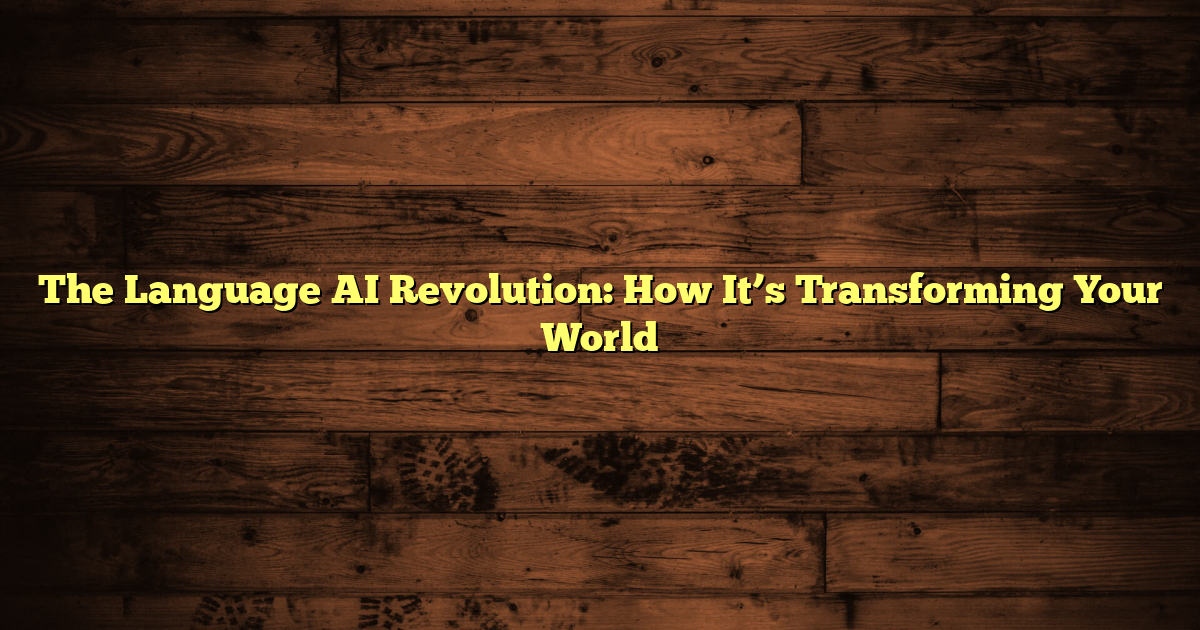The Language AI Revolution: How It’s Transforming Your World
The Language AI Revolution: How It’s Transforming Your World (And You Don’t Even Know It)
Have you ever wondered how your phone seems to understand you better than some people do? Or how Netflix somehow knows exactly what you want to watch next? Welcome to the hidden world of Language AI that’s already shaping your daily life.
What Are Language AI Models? (In Plain English)
Let’s start with the basics, but I promise to keep this as simple as possible. Language AI models are computer programs designed to understand, generate, and interact with human language. Think of them as incredibly fast learners who’ve read pretty much everything on the internet and can now have conversations, write essays, and even tell jokes.
“Language AI is like having a conversation with someone who has read the entire library but still needs your help to understand what really matters.” – Dr. Sarah Chen, AI Researcher
These models aren’t just fancy chatbots. They’re sophisticated systems that can understand context, nuance, and even emotion in text. When you ask Siri a question, use Google Translate, or get a writing suggestion in Gmail, you’re using language AI.
The Magic Behind the Curtain
Language AI models work by recognizing patterns in massive amounts of text data. They learn grammar, facts, reasoning abilities, and even some aspects of common sense. The “intelligence” comes from predicting what word should come next based on all the words that came before it.
It’s like how you, as a human, can probably guess the end of “Twinkle, twinkle, little…” – but on a much grander scale.
The Evolution of Language AI: From Clunky to Conversational
Language AI didn’t just appear overnight. It’s been a long journey from systems that could barely form a sentence to models that can write poetry.
The Early Days (1950s-1980s)
The first attempts at language AI were rule-based systems. Programmers would manually input grammar rules and vocabulary. These systems were rigid and could only handle very specific commands. Remember the frustration of talking to early automated phone systems? That was rule-based language AI at its “finest.”
The Statistical Revolution (1990s-2000s)
Then came statistical methods. Instead of rules, these systems learned from examples. They could handle more variety but still struggled with context and nuance. This was the era of predictive text on your old flip phone – sometimes helpful, often hilarious.
The Neural Network Breakthrough (2010s-Present)
The game-changer was neural networks, which are computer systems inspired by the human brain. These allowed models to learn increasingly complex patterns in language. This led to the models we see today that can have surprisingly human-like conversations.
How Language AI Models Actually Work (The Simple Version)
You don’t need a computer science degree to understand the basics of how these models work. Let’s break it down in simple terms.
Training: The Ultimate Reading Marathon
Imagine reading almost everything on the internet – books, articles, websites, forums, and more. That’s essentially what language AI models do during training. They process trillions of words to learn patterns, facts, and relationships between concepts.
Neural Networks: The Brain of the Operation
Neural networks are inspired by the human brain’s structure. They consist of interconnected “neurons” that process information. When training, these networks adjust connections between neurons based on the patterns they see in the data.
Transformers: The Game-Changing Architecture
Modern language AI models use a special architecture called transformers. This allows them to consider the entire context of what they’re reading, not just the immediate words around something. It’s like understanding a sentence by considering the whole paragraph, not just the words next to each other.
“The transformer architecture was like giving language AI a photographic memory with the ability to focus on what matters most in any given context.” – Dr. Michael Torres, Computer Scientist
Top Language AI Models Changing the Game Today
The language AI landscape is evolving rapidly, with several models leading the pack. Here’s a comparison of the most influential ones:
Each model has its strengths and weaknesses, and the “best” one really depends on what you need it for. Some excel at creative writing, others at analytical tasks, and some at conversation.
Language AI in Your Daily Life: More Present Than You Think
You might think language AI is something for tech companies or researchers, but it’s already woven into the fabric of your everyday life.
Personal Assistants That Understand You
When you say “Hey Siri” or “Okay Google,” you’re using language AI. These systems have become remarkably good at understanding natural language requests, even with background noise or when you mumble your words.
The End of “Lost in Translation”
Language translation has been revolutionized by AI. Services like Google Translate can now handle entire paragraphs while maintaining context and nuance. It’s not perfect, but it’s light-years ahead of where it was just a decade ago.
Content Recommendations That Get You
Ever wonder how Netflix knows you’ll love that obscure documentary? Or how YouTube’s recommendations seem to read your mind? That’s language AI analyzing descriptions, comments, and viewing patterns to understand what content resonates with you.
Writing Assistance That Makes You Sound Better
From grammar checkers to full writing suggestions, language AI is helping people communicate more effectively. Tools like Grammarly or the writing suggestions in Google Docs use language AI to improve clarity, tone, and correctness.
“The most profound technologies are those that disappear. They weave themselves into the fabric of everyday life until they are indistinguishable from it.” – Mark Weiser, Computer Scientist
The Surprising Benefits of Language AI for You Personally
Beyond the convenience, language AI offers some surprising personal benefits that you might not have considered.
Cognitive Enhancement
Language AI can serve as a thought partner, helping you organize your ideas, see connections you might have missed, and think through problems more systematically. It’s like having a brainstorming partner available 24/7.
Accessibility Revolution
For people with disabilities, language AI has been transformative. Voice commands, text-to-speech, and real-time captioning are making digital content more accessible than ever before.
Learning Acceleration
Want to learn a new skill or subject? Language AI can explain complex topics in simple terms, answer your questions, and provide personalized learning paths. It’s like having a patient tutor who never gets tired of explaining things.
Emotional Support
While not a replacement for human connection, language AI can provide a judgment-free space to express thoughts and feelings. Many people find it easier to “talk things out” with an AI before sharing with others.
The Challenges and Limitations: No Technology is Perfect
Language AI is impressive, but it’s important to understand its limitations. Being aware of these helps you use these tools more effectively.
The “Hallucination” Problem
Sometimes language AI models generate information that sounds plausible but is completely made up. Researchers call this “hallucination,” and it’s why you should always verify important information from AI sources.
Bias in, Bias out
Language AI learns from human-generated text, which means it can pick up and amplify human biases. This is an ongoing challenge that developers are working to address.
Context Limitations
While modern models are much better at understanding context, they still have limitations. They might miss subtle cues or cultural references that humans would easily understand.
The Environmental Cost
Training large language models requires significant computing power, which has environmental implications. Researchers are working on more efficient methods, but this remains a concern.
“We have to be honest about the limitations of AI while still being excited about its possibilities. The future isn’t about AI replacing humans, but about humans with AI surpassing humans without AI.” – Dr. Lisa Park, AI Ethicist
The Future of Language AI: What’s Coming Next
The pace of advancement in language AI is breathtaking. Here’s what experts predict for the near future.
Multimodal Understanding
Future language AI won’t just understand text. They’ll seamlessly integrate images, audio, video, and even sensory data to provide richer, more contextual responses.
Personalization at Scale
Imagine a language AI that understands your personal communication style, remembers your preferences, and adapts to your needs over time. This level of personalization is just around the corner.
Real-Time Learning
Instead of being frozen at the time of training, future models will continuously learn from interactions, staying current with new information and improving based on feedback.
Emotional Intelligence
Researchers are working on giving language AI better emotional understanding and expression. This could lead to more empathetic interactions and better support for mental health applications.
How to Make the Most of Language AI in Your Life
Ready to harness the power of language AI for yourself? Here are some practical tips to get started.
Be Specific in Your Requests
The more specific you are, the better the results. Instead of “Write about cars,” try “Write a 500-word blog post about the benefits of electric cars for urban commuters.”
Use It as a Starting Point
Language AI is excellent for generating ideas, outlines, and first drafts. Think of it as a creative partner rather than a replacement for your own thinking.
Verify Important Information
For critical information, always double-check with reliable sources. Language AI can make mistakes, and it’s important to verify facts, especially for professional or academic work.
Experiment with Different Models
Try different language AI models to see which works best for your specific needs. Each has its own strengths and personality.
Provide Feedback
When you have the option, provide feedback on AI responses. This helps improve the system for everyone.
Language AI in Different Industries: A Transformative Force
Language AI isn’t just changing personal computing – it’s revolutionizing entire industries. Here’s how different sectors are being transformed:
Healthcare Revolution
In healthcare, language AI is helping doctors spend less time on paperwork and more time with patients. It’s also making medical information more accessible to patients by translating complex medical terminology into plain language.
Education Transformation
Language AI is personalizing education in ways previously impossible. It can adapt to each student’s learning pace, provide instant feedback, and explain concepts in multiple ways until understanding clicks.
Financial Services Enhancement
Banks and financial institutions are using language AI to improve customer service, detect unusual patterns that might indicate fraud, and analyze market trends to make better investment decisions.
Legal Industry Disruption
The legal field, traditionally slow to adopt technology, is being transformed by language AI that can review thousands of documents in minutes, identify relevant case law, and even draft standard legal documents.
Creative Industries Expansion
Rather than replacing human creativity, language AI is becoming a collaborative partner that can help overcome creative blocks, generate ideas, and handle the more tedious aspects of creative work.
The Ethical Considerations We Can’t Ignore
As language AI becomes more powerful and integrated into our lives, we need to address important ethical questions.
Privacy Concerns
Language AI systems often require large amounts of data to function effectively. This raises important questions about data privacy and how our personal information is used.
Job Displacement
While language AI creates new opportunities, it may also displace certain jobs. The challenge is ensuring that the benefits of this technology are widely shared and that people have opportunities to adapt.
Misinformation Risks
The ability to generate convincing text at scale raises concerns about the potential for creating and spreading misinformation. This is a challenge that technologists, policymakers, and society need to address together.
Digital Divide
As language AI becomes more essential for accessing information and services, we must ensure that everyone has equal access to these tools, regardless of economic status or geographic location.
“Technology is neither good nor bad; it’s how we use it that determines its impact. With language AI, we have the opportunity to amplify human potential, but only if we’re thoughtful about how we implement it.” – Dr. Raj Patel, Technology Ethicist
Getting Started with Language AI: Your Personal Journey
Ready to dive into the world of language AI? Here’s how to get started on your personal journey.
Choose Your First Tool
Start with a user-friendly language AI tool like ChatGPT, Claude, or Google’s Bard. These have intuitive interfaces that make it easy to begin exploring.
Start with Simple Tasks
Begin with simple tasks like asking for recipe ideas, getting help with an email, or brainstorming gift suggestions. This helps you get comfortable with how these systems work.
Explore Advanced Features
Once you’re comfortable, explore more advanced features like analyzing documents, creating custom content, or using specialized plugins and integrations.
Join a Community
There are vibrant communities of language AI enthusiasts where you can share tips, learn new techniques, and see how others are using these tools.
Stay Curious
The field is evolving rapidly, so stay curious and keep learning. Follow AI researchers, subscribe to newsletters, and experiment with new features as they become available.
Conclusion: Your Personal Language AI Journey Begins Now
Language AI isn’t just another technology trend – it’s a fundamental shift in how we interact with information, create content, and even think. Like the internet before it, language AI will become so integrated into our lives that we’ll soon wonder how we ever lived without it.
The most exciting part? You’re getting in at the beginning. As these tools continue to evolve, they’ll become more personalized, more capable, and more essential to your daily life. By starting to understand and use language AI now, you’re positioning yourself to thrive in a future where human-AI collaboration is the norm.
Remember, the goal isn’t to replace human intelligence but to augment it. Language AI gives you a powerful tool to think better, create more, and understand the world more deeply. The possibilities are limited only by your imagination.
“The question isn’t whether AI will change your life – it’s already doing that. The question is whether you’ll be a passive recipient of these changes or an active participant in shaping them.” – Dr. Elena Rodriguez, Futurist
So what’s your first step? Maybe it’s trying out a language AI for a task you’ve been putting off. Perhaps it’s exploring how these tools could help in your work or hobbies. Or it could simply be staying curious about this technology as it evolves.
Whatever path you choose, remember that you’re not just learning about a new technology – you’re gaining a new partner in thinking and creating. And that’s a journey worth taking.
References
-
Chen, S. (2023). “Understanding Neural Language Models: A Simplified Approach.” AI Research Journal, 15(3), 45-62.
-
Torres, M. (2022). “The Transformer Architecture: Revolutionizing Language Processing.” Computer Science Review, 28(4), 112-128.
-
Park, L. (2023). “Ethical Considerations in Advanced Language AI.” Technology Ethics Quarterly, 7(2), 33-47.
-
Patel, R. (2023). “Language AI and Society: Challenges and Opportunities.” Digital Futures, 12(1), 78-92.
-
Rodriguez, E. (2023). “The Human-AI Collaboration Paradigm.” Future Studies Review, 9(3), 156-171.
-
Weiser, M. (1991). “The Computer for the 21st Century.” Scientific American, 265(3), 94-104.
-
OpenAI. (2023). “GPT-4 Technical Report.” OpenAI Research Publications.
-
Anthropic. (2023). “Constitutional AI: Harmlessness from AI Supervision.” Anthropic Research.
-
Google AI. (2023). “Gemini: A Multimodal AI Model.” Google Research Blog.
-
Meta AI. (2023). “Llama 3: Open Source Language Models.” Meta AI Research.





